For manufacturers, temperature can be a
critical indicator of the status of a piece of equipment, a process or the product
itself. Infrared sensors can be used as a useful yardstick to gauge the health of
a production line, helping to maximize efficiency and reduce costly downtime. With
the technology constantly improving and as the price of components comes down, IR
equipment is seeing increasing adoption in industry.
IR sensors can be employed as handheld or fixed/online versions
to spot defects, maintain safety levels and generally serve as preventative maintenance.
Used in plants, factories and other industrial facilities, IR thermometers provide
accurate temperature monitoring over a wide range of automation applications.
At the heart of an IR thermometer is the detector, the most important
element. There are two main groups of IR detectors. The first is the thermal detector,
which includes thermopiles, pyroelectric detectors and bolometers (for IR cameras).
The second is the quantum detector, which can react much faster to absorbed radiation
than its thermal counterparts.
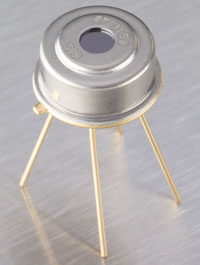
A TPS 234 industrial thermopile. Courtesy of PerkinElmer.
In simple terms, these detectors convert radiation into a small
voltage. Receiving optics such as a lens is used to direct radiation from an object
so that it lands on the detector. The resulting voltage change can then be converted
into an output signal for a given “object temperature range.” The output
from the detector is nonlinear and, therefore, conditioning electronics are required
to output a linear signal. Although the technology is already fit for purpose, IR
sensor manufacturers continue to investigate ways to improve it.
For sensor specialist Micro-Epsilon, with headquarters in Ortenburg,
Germany, advances in other fields have helped to progress the technology behind
IR sensors.
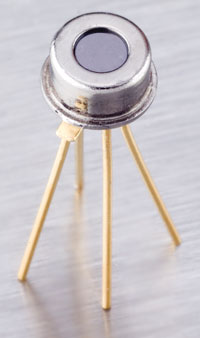
A TPS 232 thermopile in a miniature package for ear thermometers
and pyrometers. Courtesy of PerkinElmer.
“The advancement in semiconductor electronics has enabled
noncontact temperature sensors to evolve rapidly in the last 20 or so years,”
said Christopher Jones, managing director of Micro-Epsilon. “Thermopiles and
detectors have increased in sensitivity, along with digital signal processors and
integrated circuits, which have all miniaturized in size and increased in processing
power and speed in the last 20 years.”
This has enabled IR temperature sensors to become more accurate
(0.2% of range), with higher resolutions (±0.025°) and response times
as low as 1 ms, according to Jones.
“This has opened up many new applications, particularly
in high-speed production lines, with inductive heating processes, in medical applications
and virtually all manufacturing and processing environments,” he said.
Since each thermoelectric cell within a thermopile detector can
generate only a very small voltage, lots of cells are required. They are arranged
in series to produce a larger signal, resulting in a “pile” of thermocouples.
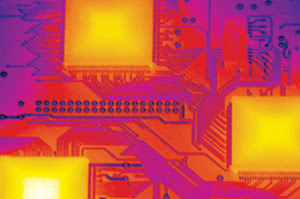
A thermal image of a printed circuit board is provided by the thermoImager TIM. Courtesy of Micro-Epsilon.
In the case of pyroelectric detectors, electronics are used to
amplify the small current flow triggered by changing low levels of thermal energy.
According to Alan Liddle, product manager at Pacer International, a UK-based supplier
of optoelectronic components, systems and displays, the US-based firm PerkinElmer
was the first to introduce digital technology to pyroelectric detectors with its
DigiPyro family.
Here, a special analog-to-digital converter circuit provides amplification
and interfacing to the outside electronics. Digital devices differ from previous
generations by offering a digital signal output. The serial interface provides the
“direct link” communication, which has a one-wire bidirectional communication
feature.
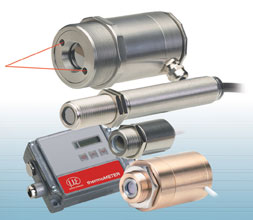
Shown is a selection of Micro-Epsilon’s thermoMeter inline pyrometers. Courtesy of
Micro-Epsilon.
“The direct link feature enables the user to have the host
microcontroller request the information and its response, so that the host controls
the communication speed,” Liddle said. “These devices belong to the
first pyroelectric detector family to provide information in bit form as opposed
to the millivolt signal of analog detectors.”
Choosing the right IR sensor
Because IR thermometers come in various configurations and designs,
which differ in optics, electronics, technology, size and housing, the choice of
which one to use comes down to its intended purpose.
Some IR sensors may be fixed at a particular station to carry
out inspection and monitoring of production lines or machinery. On the other hand,
portable IR sensors can be carried around for fast, on-the-spot inspections and
so must be designed to be lightweight, robust, able to withstand rain and able to
operate accurately in unsteady temperature conditions.
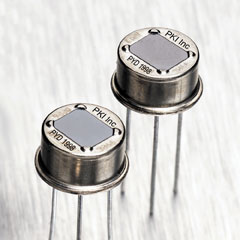
The DigiPyro PYD 1998 digital output pyrodetector from PerkinElmer combines a proven dual-element configuration with a fully integrated analog-to-digital converter for motion detection. Courtesy of PerkinElmer.
Other factors to consider are the size of the target, the distance
to the target, and its temperature range, as well as the speed of temperature change.
“The most important properties of the thermopile sensor
are its responsivity, noise, field of view, response time and, for calibrated sensors,
the temperature range,” Liddle said. “The most important electrical
data for the IR pyrosensor are its responsivity, balance and noise.”
All IR sensors typically require a clean “line of sight”
to the target for measurement of the object’s surface temperature. At some
industrial sites, particles in the air from steam, dust or smoke can obscure the
unit’s optical sight path and prevent accurate IR measurement. Nearby electromagnetic
fields or vibration can also affect the sensor’s performance.
But perhaps the most crucial property that affects the accuracy
of temperature measurement is the emissivity of an object. Emissivity is a measure
of an object’s ability to emit IR energy which, in turn, indicates the temperature
of the object.
When it comes to the IR radiation detected from an object, you
are in reality measuring three kinds of energy: energy reflected from its surface
from the surrounding environment, energy that is transmitted by the object from
background objects and the energy emitted by the object itself. An IR thermometer
will measure all three types of energy, but it is only the emitted energy that indicates
the true temperature of the object.
Emissivity is quantified by a value ranging from 0 (a shiny mirror)
to 1.0 (a blackbody), for which many of today’s IR sensors can compensate
to reduce false measurements.
However, a further complication arises when trying to measure
the temperature of a material for which the emissivity value varies with temperature
(such as a metal). Here, it is important to select an IR thermometer that operates
at the wavelength for which the material’s emissivity is at its highest value.
The trend continues
As for predicting what we can expect in the future, it seems it
will be more of the same: decreasing costs opening up more applications.
“Due to the ever-reducing cost of semiconductor electronics
combined with the extremely fast acceptance rate of IR temperature sensors, the
sales price of this technology will continue to fall,” Jones said.
Emerging applications reflect our increasingly energy-aware society.
Liddle predicts that motion detection will be used more and more for energy management
in buildings and the home, reducing energy consumption depending upon occupancy.
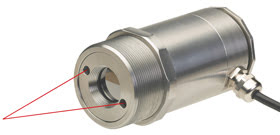
The Micro-Epsilon thermoMeter CT laser with integrated laser sighting.
Courtesy of Micro-Epsilon.
“In this case, pyrodetectors that offer thermal sensing
will increasingly be used for people detection for energy management in buildings
and the home,” he said. “Existing devices could and are being used for
this application – it’s just taking off due to energy awareness and
regulatory changes.”
Another trend for IR technology is the commercial application
of IR thermal imagers (which use bolometer technology). Once the sole domain of
military and security personnel, IR thermal imagers are following the same path
carved out by IR temperature sensors. Huge developments to simplify the technology
and improve its accuracy and measurement performance, including speed and image
processing, will result in many new markets opening up for this technology.
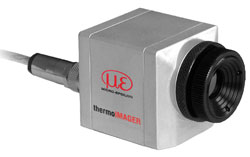
The Micro-Epsilon thermoImager TIM is a compact, in-line, high-speed thermal imager. Courtesy of Micro-Epsilon.
“This, in turn, will reduce the manufacturing costs, which
will further open up new lower-cost markets in the field of general automation and
high-volume applications,” Jones said. “We are already seeing high-end
automotive vehicles offering night-vision cameras.”
Therefore, as IR sensing technology gains the attention of commercial
markets, perhaps it won’t be long before the IR sensor will spread from production
plants and factories straight into our homes and cars.